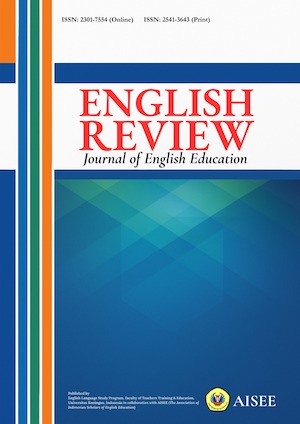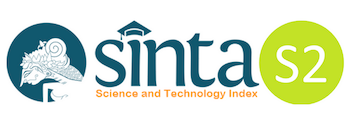CODE SWITCHING AS POLITENESS STRATEGIES IN EFL CLASSROOM INTERACTION
Abstract
Code switching and Politeness strategy are elements of communication that significantly influence classroom interaction. This paper was to reveal code switching including the reason of code switching as well as how it functions as politeness strategy in EFL classroom interaction. This study adopted a qualitative descriptive method. This research was based on the observation conducted in Universitas Negeri Makassar, in 2022. The research subject was 2 English Education classes that employed group presentation as the learning strategy. It consisted of 31 students for each class. To collect the data, the researcher recorded the classroom presentation. The recordings were then transcribed and analyzed by using discourse analysis approach. The reason of code switching was analyzed based on the theory by Hoffman (1991), and the politeness strategy was based on the rule of Politeness strategy by Brown and Levinson (1987). The result showed that code switching was used by students as politeness strategy during group presentation, and it was reflected in some maxims that were maxim of manner, maxim of relation, quality maxim, and quantity maxim. Finding of this research was significant in expanding ideas and insight about code switching that is actually can be used as politeness strategy in classroom interaction, particularly in group presentation.
References
REFERENCES
Ahmad, B. H., & Jusoff, K. (2009). Teachers' Code-Switching in Classroom Instructions for Low English Proficient Learners. English language teaching, 2(2), 49-55.
Amorim, R. (2017). Code switching in student-student interaction; functions and reasons!. Linguística Revista de Estudos Linguísticos da Universidade do Porto, 7.
Andayani, T. (2016). Code-switching, a communication strategy in learning English. Proceedings of ISELT FBS Universitas Negeri Padang, 4(2), 388-395.
Ansar, F. A. (2017). Code Switching and Code Mixing in Teaching-learning Process. English Education: Jurnal Tadris Bahasa Inggris, 10(1), 29-45.
Aprilia, S.A. (2017). Code Switching for Politeness Purposes among Sasak Speakers: Study of Selong Communities. Journal of Mataram University.
Bhatti, A., Shamsudin, S., & Said, S. B. M. (2018). Code-Switching: A Useful Foreign Language Teaching Tool in EFL Classrooms. English Language Teaching, 11(6), 93-101.
Brown, P., Levinson, S. C., & Levinson, S. C. (1987). Politeness: Some universals in language usage (Vol. 4). Cambridge university.
Cahyani, H., de Courcy, M., & Barnett, J. (2018). Teachers’ code-switching in bilingual classrooms: exploring pedagogical and sociocultural functions. International Journal of Bilingual Education and Bilingualism, 21(4), 465-479.
Gardner-Chloros, P., & Finnis, K. (2003). How code-switching mediates politeness: Gender-related speech among London Greek-Cypriots. Sociolinguistic Studies, 505-532.
Hoffman, C. (1991). An Introduction to Bilingualism. New York: Longman.
Hutauruk, B.S. (2016). Code Switching in Bilingual Classes: A Case Study of Three Lectureres at Bunda Mulia University. Journal of English Teaching as a Foreign Langauge, 2(1).
Ibrahim, E. H. E., Shah, M. I. A., & Armia, N. T. (2013). Code-Switching in English as a Foreign Language Classroom: Teachers' Attitudes. English Language Teaching, 6(7), 139-150.
Jingxia, L. (2010). Teachers’ Code-switching to the L1 in EFL Classroom. The Open Applied Linguistics Journal.Vol 3. 10-23.
Kumar, T., Nukapangu, V., & Hassan, A. (2021). Effectiveness of code-switching in language classroom in India at primary level: a case of L2 teachers’ perspectives. Pegem Journal of Education and Instruction, 11(4), 379-385.
Mujiono, Poedjosoedarmo, S., Subroto, E. and Wiratno, T. (2013). Code Switching in English as Foreign Language Instruction Practiced by the English Lecturers at Universities. International Journal of Linguistics 5(2).
Nurhamidah, N., Fauziati, E., & Supriyadi, S. (2018). Code-Switching in EFL Classroom: Is It Good or Bad?. Journal of English Education, 3(2), 78-88.
Pradina, F.A., Soerisasoemantri, and Heriyanto. (2013). Code-switching as the Positive Politeness Strategies in Indonesian 4th Grade Students’ Conversation. Research on Humanities and Social Science, 3(22).
Rasman, R. (2018). To translanguage or not to translanguage? The multilingual practice in an Indonesian EFL classroom. Indonesian Journal of Applied Linguistics, 7(3), 687-694.
Üstünel, E. (2016). EFL classroom code-switching. Palgrave Macmillan.
Yao, M. (2011). On Attitudes to Teachers’ Code-switching in EFL Classes. World Journal of English Language, 1(1).
All articles published in English Review: Journal of English Education (ERJEE) are licensed under the Creative Commons Attribution 4.0 International License (CC BY 4.0).
Copyright Ownership
Authors retain the copyright of their articles and grant ERJEE the right of first publication. The journal is granted a non-exclusive license to publish, reproduce, and distribute the article in any format, medium, or platform, provided that proper credit is given to the original authors.
License Terms – CC BY 4.0
Under the Creative Commons Attribution 4.0 International License, others are free to:
- Share — copy and redistribute the material in any medium or format
- Adapt — remix, transform, and build upon the material for any purpose, even commercially
As long as they:
- Provide appropriate credit to the original author(s) and source
- Provide a link to the license (https://creativecommons.org/licenses/by/4.0/)
- Indicate if any changes were made
There are no restrictions on the reuse, reproduction, or adaptation of published articles as long as attribution is properly given.
Author Warranties
By submitting a manuscript to ERJEE, authors confirm that:
- The work is original and does not infringe any existing copyright.
- The manuscript has not been previously published and is not under consideration elsewhere.
- All sources and references are appropriately acknowledged.
- Necessary permissions have been obtained for any copyrighted materials used.









